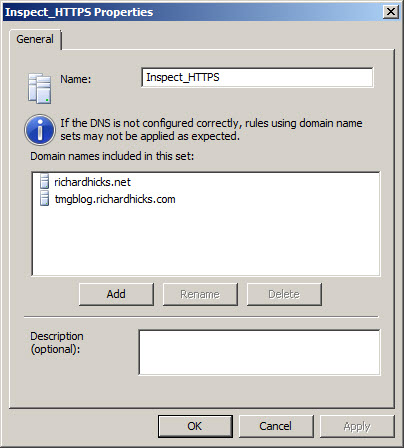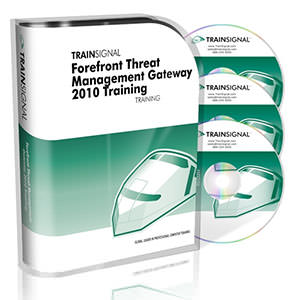Archive
Hotfix Rollup 1 for Forefront TM 2010 SP2 Now Available
A hotfix rollup for Forefront TMG 2010 SP2 is now available. The hotfix rollup resolves several reported issues with TMG, including:
KB2654016 – A client may be unsuccessful in accessing a Java SSO application published to the web by Forefront TMG 2010
KB2653703 – “Error: Subreport could not be shown” error message in the User Activity or Site Activity report in Forefront TMG 2010
KB2654585 – UDP packets may become backlogged when you increase the “maximum concurrent UDP sessions per IP address” setting in Forefront TMG 2010
KB2624178 – Forefront TMG 2010 administrators may be unable to generate reports
KB2636183 – Both sides of a TCP connection are closed when the client or remote application half-closes the TCP connection in Forefront TMG 2010
KB2653669 – Summary information for the Top Overridden URLs table and for the Top Rule Override Users table display incorrect information in Forefront TMG 2010
KB2617060 – Forefront TMG 2010 enables L2TP site-to-site connections in RRAS
KB2655951 – Japanese characters in the subject line of an Alert email message are not readable in the Japanese version of Forefront TMG 2010
KB2654068 – “The Web Listener is not configured to use SSL” warning message may occur when you configure a Web Listener to use a valid SSL certificate in Forefront TMG 2010
KB2654193 – You receive a “Bad Request” error message when you try to access Outlook Web App published by Forefront TMG 2010
KB2654074 – String comparison may become case-sensitive when you published a website using Forefront TMG 2010
KB2658903 – Forefront TMG 2010 firewall service (wspsrv.exe) may crash frequently for a published website secured by SSL after you install Service Pack 2.
Hotfix rollup 1 for Forefront TMG 2010 SP2 can be downloaded here. After applying this update, the new Forefront TMG 2010 build number will be 7.0.9193.515.
TrainSignal Forefront TMG 2010 Training
Are you looking for Forefront TMG 2010 training? If so, take a look at TrainSignal’s Forefront TMG 2010 training package. This is a comprehensive video training course that includes 8 hours of video instruction over 21 modules. Scott Lowe does an excellent job of delivering the course, which is available online and on disc. I had the privilege of serving as the technical reviewer for this video training series, so I can assure you the material is exceptional.
If you are planning to deploy Forefront TMG 2010 in the future, or perhaps you are considering a migration from previous versions of ISA server to Forefront TMG 2010, the TrainSignal Forefront TMG 2010 video training series is an excellent investment. Check it out now!
Error 0xc0040431 When Creating a Forefront TMG 2010 Enterprise Array
When attempting to join a Forefront TMG 2010 enterprise edition firewall to an Enterprise Management Server (EMS) managed array, you may encounter one of the following error messages:
The operation failed. Error: 0xc0040431 Forefront TMG Services failed to start after array join or an array disjoin. Check alerts, fix the configuration, and attempt to restart the services.

The operation failed. Error: 0xc0040410 The file cannot be imported because the enterprise management mode is 2010SP1 in the exported file and 2008-only in the stored configuration.

You may also encounter one of the following error messages when attempting to create a standalone array with two or more Forefront TMG 2010 enterprise edition firewalls:
The operation failed. Error: 0x80004002 No such interface supported

The operation failed. Error: 0xc0040410 The file cannot be imported because the enterprise management mode is in the exported file and in the stored configuration.

Any of these errors can occur when you attempt to join a pre-SP2 Forefront TMG 2010 firewall to an EMS-managed array running Forefront TMG SP2, or when you attempt to create a standalone array with one node running Forefront TMG SP2 and another node running SP1.
To resolve this issue, make certain that Forefront TMG 2010 firewalls are all at the same service pack and update level before joining an EMS-managed array or creating a standalone array. For information about determining which version of ISA or TMG is installed, refer to one of the following blog posts:
https://tmgblog.richardhicks.com/2010/10/11/how-to-determine-tmg-version/
https://tmgblog.richardhicks.com/2010/12/03/more-about-determining-tmg-version-numbers/
For a documented reference of ISA and TMG build numbers, click here.
Configuring Forefront TMG 2010 HTTPS Inspection Inclusion List
When HTTPS inspection is configured and enabled on a Forefront TMG 2010 firewall, the administrator has the option to define web sites to exclude from HTTPS inspection. This may be required for a variety of reasons. For example, an administrator may need to exclude certain destinations to address privacy concerns, or perhaps HTTPS inspection breaks an application that uses SSL to tunnel non-HTTP protocols. All HTTPS web sites are inspected except for those sites defined as Destination Exceptions.

Beginning with Service Pack 2 (SP2) for Forefront TMG 2010, administrators can now define an explicit inclusion list for HTTPS inspection. Sites included on this list will be subject to HTTPS inspection, while all other destinations will be excluded. To define an HTTPS inspection inclusion list, create a Domain Name Set and populate it with those destinations for which you explicitly want to enforce HTTPS inspection.

After saving and applying the configuration, copy this VBScript file to the TMG firewall, then open an elevated command prompt and type the following command:
cscript.exe ConfigureHTTPSiInclusionList.vbs <DomainNameSetName>
Substitute <DomainNameSetName> in the command above with the name of the Domain Name Set created earlier. Once configured, the Destination Exceptions tab of the HTTPS Outbound Inspection properties will be greyed out, and only those sites included in the Domain Name Set defined as the HTTPS inspection inclusion list will be subject to HTTPS inspection. All other destinations will be excluded. You can still define Source Exceptions as needed, however.

Only one Domain Name Set can be specified as the HTTPS inspection inclusion list. Running the command without parameters removes any configured inclusion list and returns HTTPS inspection back to its original state.
For more information regarding HTTPS inspection inclusion lists, refer to KB2619986.
Forefront TMG 2010 Service Pack 2 Now Available
Service Pack 2 for Microsoft Forefront TMG 2010 is now available. In addition to numerous fixes released since SP1 and SP1 hotfix rollup 4, this service pack also includes the following new features:
New reports – A new site activity report that provides details about requests made to specific web sites for individual users.
New error pages – TMG SP2 provides the option to use new error pages that feature a whole new look and feel. In addition, these new error pages are more easily customized and can now include embedded objects.
Kerberos authentication for NLB – TMG SP2 includes the ability to leverage Kerberos authentication for clients accessing enterprise arrays via the NLB virtual IP address (VIP).
You can download Forefront TMG 2010 service pack 2 here. Please note that this update requires that Forefront TMG 2010 SP1 and software update 1 for TMG SP1 be installed prior to installing Forefront TMG 2010 SP2. Once TMG SP2 has been installed successfully the build number will be 7.0.9193.500.
For information regarding the installation of SP2 for Forefront TMG 2010 on enterprise arrays, click here.





